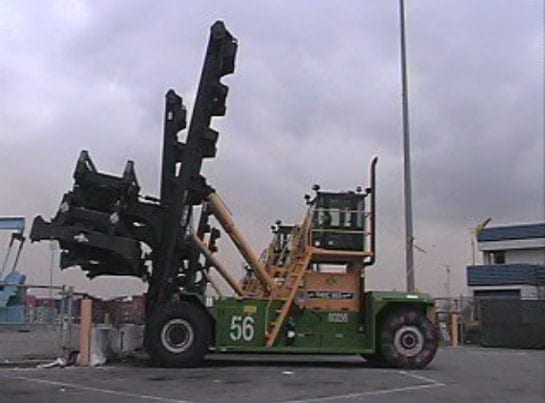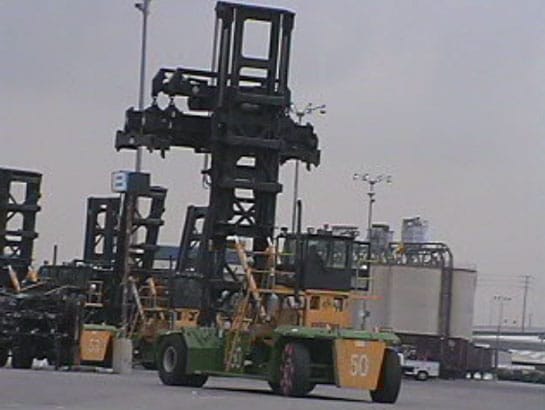A Security Guard Is Killed When He Was Run Over By A Heavy-duty Industrial Forklift While Directing Traffic In A Cargo Container Storage Yard
Investigation: # 02CA007
SUMMARY
A 50-year-old security guard died when he was run over by a heavy-duty industrial forklift used to top load cargo containers. He was directing traffic in the yard at the time of the incident. This was part of his normal duties. The forklift operator did not follow the victim’s traffic directions. The victim had no formal training in traffic control. The CA/FACE investigator determined that, in order to prevent future occurrences, employers, as part of their Injury and Illness Prevention Program (IIPP), should:
- Ensure forklift operators follow the directions of workers directing traffic.
- Consider installing structures that would ensure protection to employees on foot in the area of forklifts.
- Ensure that employees directing traffic have formal training in traffic control
INTRODUCTION
On September 3, 2002, at approximately 11:45 am, a 50-year-old security guard was killed when he was run over by a heavy-duty industrial forklift used to load cargo containers. The CA/FACE investigator learned of this incident on September 12, 2002, through the Legal Unit of the Division of Occupational Safety and Health (Cal/OSHA). On October 22, 2002, the CA/FACE investigator traveled to the victim’s place of employment where he interviewed the company safety representatives and reviewed the company’s safety policies and procedures. He then traveled to the incident scene and interviewed other employees. Pictures of the incident site and similar equipment that was involved in the incident were taken. A copy of the police report was also reviewed.
The employer of the victim was a cargo container storage and shipping company that has been in business for over 100 years. The company had about 3,000 employees. The location where the victim reported had 120 employees. The victim had been employed with the company for 20 years and was the security guard supervisor. The employer of the victim had a written safety program and an injury and illness prevention program with all the required elements. There were written codes of safe practices available at the site where the victim worked. Daily tailgate safety meetings were mandated and formal safety meetings were held monthly and were documented.
The company had a comprehensive training program. Training was usually accomplished through classroom and on-the-job-training (OJT). All forklift operators were certified and licensed as required by the company and California law. Documentation of employee training was kept on file. The victim was never formally trained in traffic control.
INVESTIGATION
The site of the incident was a large shipping terminal at a harbor. The terminal was used to unload cargo containers from ships and store them until ready for shipment by truck. The entire multi-acre terminal work yard was paved. The transfer of cargo containers from storage to trucks was accomplished by using large 168,000-pound heavy-duty industrial forklifts, also referred to as top handlers, that had attachments on the forks to pick up the cargo containers from the top.
On the day of the incident, the victim, wearing a reflective vest and hardhat, was directing traffic on a designated roadway that had been delineated by painted markings on the work yard pavement. Trucks used this designated roadway to exit the facility. According to the victim’s supervisor, the victim directed traffic in that area between Mondays and Fridays from 11:30 am to 12:30 pm to control the volume and speed of the trucks exiting the facility and to prevent forklifts from parking in the employee parking lot.
The driver of the forklift told the police that he had just dropped off a container and was going to park the forklift and go to lunch. He stated he saw the victim as he came around a row of cargo containers. He also stated the victim had his back to him and was pointing with his arm in a southeasterly direction toward the forklift parking lot. The driver instead turned northeast and lost sight of the victim. The forklift struck the victim, entangling him in the left front tandem tires. The forklift operator told the police that he slammed on the brakes when he lost sight of the victim. Truck drivers and other personnel in the area rushed to the incident scene to help. Those with cell phones called 911. The paramedics and ambulance arrived and pronounced death immediately.
CAUSE OF DEATH
The cause of death, according to the death certificate, was traumatic injuries.
RECOMMENDATIONS/DISCUSSION
Recommendation #1: Ensure forklift operators follow the directions of workers directing traffic.
Discussion: Heavy equipment operators usually have designated areas where they can operate and park. In this case, the forklifts had a specific area assigned to them for parking when not in use. In this incident, the victim directed the forklift operator toward the forklift parking lot. The forklift operator instead turned the forklift in a different direction, toward the employees’ parking lot. By not following the victim’s directions, the operator changed the conditions under which the victim made his assumptions about safe areas to walk. As a trained and licensed operator, he should have followed the directions of those directing traffic. Employers can ensure safe work practices by establishing work procedures through programs of training, supervision, safe work recognition, and progressive disciplinary measures.
Recommendation #2: Consider installing structures that would ensure protection to employees on foot in the area of forklift.
Discussion: Traffic controllers, security guards, and other employees whose duties require them to work in close proximity to forklifts and other heavy equipment with large blind spots are often in need of a greater degree of protection than workers exposed to smaller vehicles. At any given moment a change could occur that places them in immediate danger. Crows nests, traffic control towers, or other structures remove the workers from immediate danger while allowing them to perform their duties.
Recommendation #3: Ensure that employees directing traffic have formal training in traffic control.
Discussion: A key concept in traffic control safety training is that the person directing traffic should always face oncoming traffic. Had the victim been trained in traffic control and always faced the forklift, he would have seen that the operator was not following his directions, and this incident might have been prevented.
REFERENCES
- California Code of Regulations, Vol. 9, Title 8, Sections 3661(c), 3664(b), 3668(a)
FATALITY ASSESSMENT AND CONTROL EVALUATION PROGRAM
The California Department of Health Services, in cooperation with the California Public Health Institute, and the National Institute for Occupational Safety and Health (NIOSH), conducts investigations on work-related fatalities. The goal of this program, known as the California Fatality Assessment and Control Evaluation (CA/FACE), is to prevent fatal work injuries in the future. CA/FACE aims to achieve this goal by studying the work environment, the worker, the task the worker was performing, the tools the worker was using, the energy exchange resulting in fatal injury, and the role of management in controlling how these factors interact.
NIOSH funded state-based FACE programs include: Alaska, California, Iowa, Kentucky, Massachusetts, Michigan, Minnesota, Nebraska, New Jersey, New York, Oklahoma, Oregon, Washington, West Virginia, and Wisconsin.
To contact California State FACE program personnel regarding State-based FACE reports, please use information listed on the Contact Sheet on the NIOSH FACE website. Please contact In-house FACE program personnel regarding In-house FACE reports and to gain assistance when State-FACE program personnel cannot be reached.
EXHIBITS
 |
| Exhibit 1. A side view of a forklift “top handler” similar to the one involved in the incident. |
 |
| Exhibit 2. A rear view of a forklift “top handler” similar to the one involved in the incident. |
 |
| Exhibit 3. A picture of the incident scene looking west. The forklift came from the area to the right of the picture. |
 |
| Exhibit 4. A picture of the incident scene looking east. The forklift parking area is on the right of the picture. The employee parking lot is on the left of the picture. The top handler was headed to the area on the left of the picture. |
